Tags
- Acer saccharum
- American Beech Tree
- American Chestnut Tree
- American Elm
- American Forests
- American Hop Hornbeam
- American Linden
- American Oak Tree
- American Sycamore
- American planetree
- Anemone
- Anthracnose
- Apple Tree Borer
- Apples
- Arbor Day
- Arboreturn America
- Arborvitae
- Aspens
- Austrian Pine
- Autumn
- BNI
- Bald Eagle
- Baldcypress
- Barred Owl
- Bellwort
- Betula Nigra
- Betula alba
- Betula papyrifera
- Birch
- Black Cherry
- Black Locust
- Black Oak
- Bloodroot
- Blue Spruce
- Burr Oak
- Business Networking International
- Buttonball tree
- Callery Pears
- Captain
- Carya illinoensis
- Carya ovata
- Catalpa
- Catalpa speciosa
- Cedar
- Cedar Waxwing
- Celtis occidentalis
- Cercis canadensis
- Chalet Garden Centers
- Chicago Botanic Garden
- Chicago summers
Resource Articles from Gilbert Smith, ISA Board Certified Master Arborist
and Lesley Bruce Smith, ISA Certified Arborist

How Do Trees Heal?
Backyard Wisdom, April 2019
by: Gilbert A Smith, ISA Certified Master Arborist
They don’t, at least not the way we think of healing. Damaged tissue in our bodies is replaced by new healthy tissue. Once a tree is damaged, however, it remains damaged for the rest of its life. This is because trees don't grow like people. Maybe a better comparison would be that trees grow like coral, annually adding new living layers on top of old mostly dead structure. We can count these new layers or annual rings to tell us just how many years the tree has been alive. Because of this “layered” growth pattern, no matter how tall a tree grows, the height of each individual branch on the trunk never changes.
How Do Trees Grow?
Mother Nature’s Moment, April 2019
by: Lesley Bruce Smith, ISA Certified Arborist
This last quarter we have taught several workshops that focus on tree trimming. Whenever we have a chance to get in front of people to talk about trees, we don’t miss the opportunity to talk about tree physiology. Now before you click to the next thing with a big yawn, give me a moment to share with you just how exciting this subject can be. Understanding tree physiology helps those of us that live and work with trees to know how to help them live the longest and healthiest lives possible. As an arborist of almost 40 years I can tell you that some of the most damaging practices done to and around trees are done because of the many misconceptions we have about them. Understanding a bit about how trees live and grow helps us to be good tree friends.


